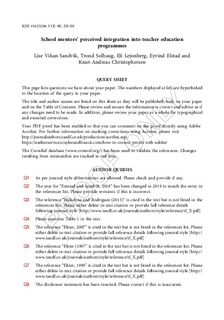| dc.contributor.author | Sandvik, Lise Vikan | |
| dc.contributor.author | Solhaug, Trond | |
| dc.contributor.author | Lejonberg, Eli | |
| dc.contributor.author | Elstad, Eyvind | |
| dc.contributor.author | Christophersen, Knut-Andreas | |
| dc.date.accessioned | 2019-12-17T08:41:05Z | |
| dc.date.available | 2019-12-17T08:41:05Z | |
| dc.date.created | 2019-06-11T14:48:45Z | |
| dc.date.issued | 2019 | |
| dc.identifier.citation | Professional Development in Education. 2019, 1-16. | nb_NO |
| dc.identifier.issn | 1941-5257 | |
| dc.identifier.uri | http://hdl.handle.net/11250/2633524 | |
| dc.description.abstract | There is often a fragmentation between campus-based theoretical preparation of pre-service teachers and their practice in schools supported by school-based mentors. One of the fragmentation issues is related to how school-based teachers being mentors for pre-service teachers consider themselves as teachers and as ‘teacher educators’. Thus, school mentors play a key role in integrating theoretical and practical knowledge and integration thus involves a two-way relationship between mentors in schools learning from teacher education programmes and educational programs learning from educational practices in school. This study addresses the problem of fragmentation by focusing on factors which contribute to mentors perceived integration in teacher education programs. We have collected questionnaires from 293 mentors and analysed data using structural equation models (SEM) in IBM/Amos. We include mentors’ specific education and training for mentoring, their affective commitment to mentoring, their active use of theory and their positive believes about successful outcome of their mentoring as important variables. We also explore how gender and years of mentor practice might contribute to mentor integration. We compared participants from three university programmes. The implications of this research for teacher practice are discussed. | nb_NO |
| dc.language.iso | eng | nb_NO |
| dc.publisher | Taylor & Francis | nb_NO |
| dc.title | School mentors’ perceived integration into teacher education programmes | nb_NO |
| dc.type | Journal article | nb_NO |
| dc.type | Peer reviewed | nb_NO |
| dc.description.version | acceptedVersion | nb_NO |
| dc.source.pagenumber | 1-16 | nb_NO |
| dc.source.journal | Professional Development in Education | nb_NO |
| dc.identifier.doi | 10.1080/19415257.2019.1623286 | |
| dc.identifier.cristin | 1704079 | |
| dc.description.localcode | Locked until 25 November 2020 due to copyright restrictions. This is an Accepted Manuscript of an article published by Taylor & Francis in Professional Development in Education on 25 May 2019, available at https://doi.org/10.1080/19415257.2019.1623286. | nb_NO |
| cristin.unitcode | 194,67,80,0 | |
| cristin.unitname | Institutt for lærerutdanning | |
| cristin.ispublished | true | |
| cristin.fulltext | postprint | |
| cristin.qualitycode | 1 | |
